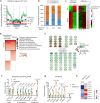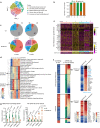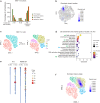Impaired histone inheritance promotes tumor progression
- PMID: 37301892
- PMCID: PMC10257670
- DOI: 10.1038/s41467-023-39185-y
Impaired histone inheritance promotes tumor progression
Abstract
Faithful inheritance of parental histones is essential to maintain epigenetic information and cellular identity during cell division. Parental histones are evenly deposited onto the replicating DNA of sister chromatids in a process dependent on the MCM2 subunit of DNA helicase. However, the impact of aberrant parental histone partition on human disease such as cancer is largely unknown. In this study, we construct a model of impaired histone inheritance by introducing MCM2-2A mutation (defective in parental histone binding) in MCF-7 breast cancer cells. The resulting impaired histone inheritance reprograms the histone modification landscapes of progeny cells, especially the repressive histone mark H3K27me3. Lower H3K27me3 levels derepress the expression of genes associated with development, cell proliferation, and epithelial to mesenchymal transition. These epigenetic changes confer fitness advantages to some newly emerged subclones and consequently promote tumor growth and metastasis after orthotopic implantation. In summary, our results indicate that impaired inheritance of parental histones can drive tumor progression.
© 2023. The Author(s).
Conflict of interest statement
The authors declare no competing interests.
Figures






Similar articles
-
Symmetric inheritance of parental histones contributes to safeguarding the fate of mouse embryonic stem cells during differentiation.Nat Genet. 2023 Sep;55(9):1555-1566. doi: 10.1038/s41588-023-01477-w. Epub 2023 Sep 4. Nat Genet. 2023. PMID: 37666989 Free PMC article.
-
MCM2 promotes symmetric inheritance of modified histones during DNA replication.Science. 2018 Sep 28;361(6409):1389-1392. doi: 10.1126/science.aau0294. Epub 2018 Aug 16. Science. 2018. PMID: 30115746
-
Coordination of histone chaperones for parental histone segregation and epigenetic inheritance.Genes Dev. 2024 Mar 22;38(3-4):189-204. doi: 10.1101/gad.351278.123. Genes Dev. 2024. PMID: 38479839 Free PMC article.
-
Histone variants and epigenetic inheritance.Biochim Biophys Acta. 2013 Mar-Apr;1819(3-4):222-229. doi: 10.1016/j.bbagrm.2011.06.007. Biochim Biophys Acta. 2013. PMID: 24459724 Review.
-
Transgenerational inheritance: how impacts to the epigenetic and genetic information of parents affect offspring health.Hum Reprod Update. 2019 Sep 11;25(5):518-540. doi: 10.1093/humupd/dmz017. Hum Reprod Update. 2019. PMID: 31374565
Cited by
-
Replication-coupled inheritance of chromatin states.Cell Insight. 2024 Aug 23;3(6):100195. doi: 10.1016/j.cellin.2024.100195. eCollection 2024 Dec. Cell Insight. 2024. PMID: 39391004 Free PMC article. Review.
-
Crosstalk between metabolic and epigenetic modifications during cell carcinogenesis.iScience. 2024 Nov 15;27(12):111359. doi: 10.1016/j.isci.2024.111359. eCollection 2024 Dec 20. iScience. 2024. PMID: 39660050 Free PMC article. Review.
-
Monitoring and quantifying replication fork dynamics with high-throughput methods.Commun Biol. 2024 Jun 14;7(1):729. doi: 10.1038/s42003-024-06412-1. Commun Biol. 2024. PMID: 38877080 Free PMC article. Review.
-
Roles for the 3D genome in the cell cycle, DNA replication, and double strand break repair.Front Cell Dev Biol. 2025 Feb 27;13:1548946. doi: 10.3389/fcell.2025.1548946. eCollection 2025. Front Cell Dev Biol. 2025. PMID: 40083661 Free PMC article. Review.
-
Redistribution of mutation risk in cancer.Nat Cancer. 2024 Feb;5(2):216-217. doi: 10.1038/s43018-024-00728-x. Nat Cancer. 2024. PMID: 38418776 Free PMC article. No abstract available.
References
Publication types
MeSH terms
Substances
Grants and funding
LinkOut - more resources
Full Text Sources
Molecular Biology Databases
Research Materials
Miscellaneous

